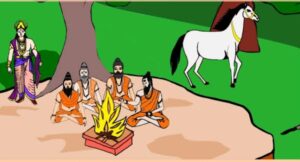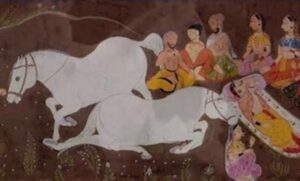Yudhishthira Epic Ashwamedha Yagna After Kurukshetra War
In the Mahabharata, Yudhishthira, the eldest of the Pandava brothers, performs the Ashwamedha Yagna (Horse Sacrifice) after the Kurukshetra War and his coronation as the king. This event is significant in the context of Yudhishthira’s rule and his efforts to establish righteousness (dharma) in the kingdom. Here’s a brief overview of Yudhishthira’s Ashwamedha Yagna:
Post-War Period:
After the Kurukshetra War, Yudhishthira was crowned as the king of Hastinapura. However, he was filled with remorse over the immense loss of life in the war and sought to atone for it.
The Decision to Perform the Yagna:
Yudhishthira, guided by Lord Krishna and advised by sages and elders, decided to conduct the Ashwamedha Yagna as a means to purify the kingdom and ensure its prosperity. It was also a symbolic gesture to establish his authority as the righteous ruler.
Ritual Preparations:
The Ashwamedha Yagna required extensive preparations. A sacred horse was selected and allowed to roam freely, followed by Yudhishthira’s army. Any neighboring rulers who challenged the horse’s passage were expected to engage in battle, which was part of the ritual.
Religious and Ritual Components:
The Yagna involved elaborate Vedic rituals, including the construction of a yagnashala (fire altar) and the offerings of various oblations into the sacred fire. Priests chanted Vedic hymns and conducted rites.
Symbolic Sacrifice:
As part of the ritual, the horse was ritually “sacrificed.” In reality, the horse was not killed, but a symbolic ritual act took place to signify the horse’s “sacrifice.”
Benefits and Blessings:
Yudhishthira believed that by performing the Ashwamedha Yagna, he would bring blessings to his kingdom and ensure its well-being and spiritual prosperity. It was also seen as a means of seeking forgiveness for the sins committed during the war.
Political and Religious Symbolism:
Yudhishthira’s performance of the Ashwamedha Yagna carried political and religious significance. It asserted his authority as the legitimate ruler and also reinforced his commitment to upholding dharma (righteousness) in his kingdom.
The Ashwamedha Yagna performed by Yudhishthira was a way for him to reconcile with the consequences of the war and establish a sense of order and righteousness in his kingdom. It also reflected the complex interplay between politics, religion, and morality in the Mahabharata narrative.



